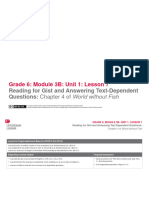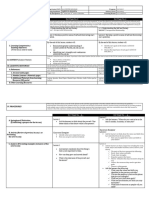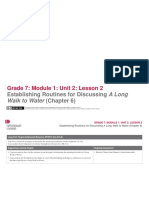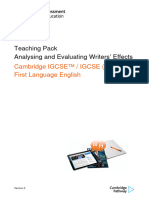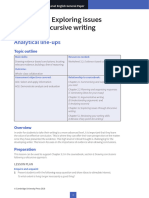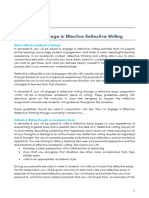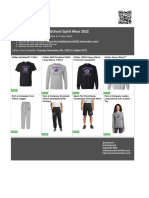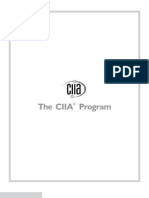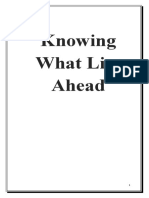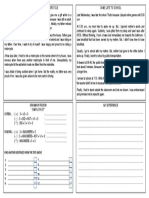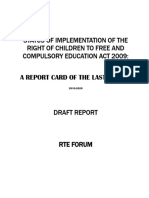Grade 6: Module 3B: Unit 2: Lesson 5: Mid-Unit Assessment: Analyzing Point of View and
Grade 6: Module 3B: Unit 2: Lesson 5: Mid-Unit Assessment: Analyzing Point of View and
Uploaded by
Unknown WomenCopyright:
Available Formats
Grade 6: Module 3B: Unit 2: Lesson 5: Mid-Unit Assessment: Analyzing Point of View and
Grade 6: Module 3B: Unit 2: Lesson 5: Mid-Unit Assessment: Analyzing Point of View and
Uploaded by
Unknown WomenOriginal Title
Copyright
Available Formats
Share this document
Did you find this document useful?
Is this content inappropriate?
Copyright:
Available Formats
Grade 6: Module 3B: Unit 2: Lesson 5: Mid-Unit Assessment: Analyzing Point of View and
Grade 6: Module 3B: Unit 2: Lesson 5: Mid-Unit Assessment: Analyzing Point of View and
Uploaded by
Unknown WomenCopyright:
Available Formats
Grade 6: Module 3B: Unit 2: Lesson 5
Mid-Unit Assessment: Analyzing Point of View and
Plot Development in Flush
This work is licensed under a Creative Commons Attribution-NonCommercial-ShareAlike 3.0 Unported License.
Exempt third-party content is indicated by the footer: © (name of copyright holder). Used by permission and not subject to Creative Commons license.
GRADE 6: MODULE 3B: UNIT 2: LESSON 5
Mid-Unit Assessment:
Analyzing Point of View and Plot Development in Flush
Long-Term Targets Addressed (Based on NYSP12 ELA CCLS)
I can determine the meaning of literal, connotative, and figurative language (metaphors and similes) in literary text. (RL.6.4)
I can analyze how an author’s word choice affects tone and meaning in a literary text. (RL.6.4)
I can analyze how a particular sentence, stanza, scene, or chapter fits in and contributes to the development of a literary text. (RL.6.5)
I can analyze how an author develops a narrator or speaker’s point of view. (RL.6.6)
I can use context (e.g., the overall meaning of a sentence or paragraph, a word’s position or function in a sentence) to determine the meaning of a word or phrase.
(L.6.4a)
Supporting Learning Targets Ongoing Assessment
• I can determine the meaning of words and phrases in the text. • Structured notes: Chapters 6 and 7 (from homework)
• I can analyze how the word choice affects tone and meaning. • Mid-Unit 2 Assessment: Point of View, Figurative
• I can analyze how Hiaasen develops Noah’s point of view. Language, and Plot Development in Flush
• I can explain how a chapter contributes to plot development. • Flush Plot Development anchor chart
Created by Expeditionary Learning, on behalf of Public Consulting Group, Inc.
© Public Consulting Group, Inc., with a perpetual license granted to Expeditionary
Learning Outward Bound, Inc. NYS Common Core ELA Curriculum • G6:M3B:U2:L5 • June 2014 • 1
GRADE 6: MODULE 3B: UNIT 2: LESSON 5
Mid-Unit Assessment:
Analyzing Point of View and Plot Development in Flush
Agenda Teaching Notes
1. Opening • In this Mid-Unit 2 Assessment, students read a passage of Flush and are asked to identify and interpret
A. Engaging the Reader: Chapters 6 and 7 of Flush (7 the point of view and use of figurative language in the passage. They do this in a graphic organizer
minutes) nearly identical to the one they have been using to track point of view throughout the novel so far.
B. Unpacking Learning Targets (2 minutes) Students are then asked a series of short constructed response questions about figurative language,
2. Work Time word choice, and plot development.
A. Mid-Unit 2 Assessment (33 minutes) • Assess student responses using the NYS Grade 6 2-Point Rubric—Short Response. There are also
3. Closing and Assessment suggested answers in the supporting materials, but be aware that student answers may differ from those
A. Debrief (3 minutes) suggested—they are to be used as a guideline for the kind of responses to look for.
4. Homework • Consider allowing time for catch-up reading to ensure all students are at the same place in the book.
A. Read the rest of Chapter 8. As you read, mark the • In advance:
text with evidence flags to help you answer the focus – Review Concentric Circles protocol (see Appendix).
question in your structured notes.
• Post: Learning targets; Plot Development: The Rising Action in Flush anchor chart; Flush Plot
B. Record new vocabulary words on your word-catcher. Development anchor chart.
Created by Expeditionary Learning, on behalf of Public Consulting Group, Inc.
© Public Consulting Group, Inc., with a perpetual license granted to Expeditionary
Learning Outward Bound, Inc. NYS Common Core ELA Curriculum • G6:M3B:U2:L5 • June 2014 • 2
GRADE 6: MODULE 3B: UNIT 2: LESSON 5
Mid-Unit Assessment:
Analyzing Point of View and Plot Development in Flush
Lesson Vocabulary Materials
Do not preview vocabulary. • Plot Development: The Rising Action in Flush anchor chart (from Lesson 3)
• Plot Development: The Rising Action in Flush anchor chart (answers, for teacher reference)
• Flush Plot Development anchor chart (from Lesson 2)
• Mid-Unit 2 Assessment: Analyzing Point of View and Plot Development in Flush (one per student)
• Flush (book; distributed in Lesson 1)
• Sticky notes (five per student)
• Colored pencils or markers (blue and one other color; one of each color per student)
• Mid-Unit 2 Assessment: Analyzing Point of View and Plot Development in Flush (suggested answers, for teacher reference)
• NYS Grade 6 2-Point Rubric—Short Response (for teacher reference)
• Structured notes (from Lesson 1; one new blank copy per student)
• Evidence flags (at least three per student)
Created by Expeditionary Learning, on behalf of Public Consulting Group, Inc.
© Public Consulting Group, Inc., with a perpetual license granted to Expeditionary
Learning Outward Bound, Inc. NYS Common Core ELA Curriculum • G6:M3B:U2:L5 • June 2014 • 3
GRADE 6: MODULE 3B: UNIT 2: LESSON 5
Mid-Unit Assessment:
Analyzing Point of View and Plot Development in Flush
Opening Meeting Students’ Needs
A. Engaging the Reader: Chapters 6 and 7 of Flush (7 minutes) • Opening the lesson by asking
• Invite students to refer to their structured notes homework and the answer to the focus question: students to share their homework
* “What does Shelly think of Lice in Chapter 6? How do you know?” makes them accountable for
completing it. It also gives you the
• Remind students of Concentric Circles protocol:
opportunity to monitor which
1. Split the group in half. Invite one half to make a circle facing out and the other half to make a circle around them, facing students are not doing their
in. homework.
2. Ensure that all students are facing someone opposite them.
3. Ask: “What happened in Chapter 6?”
4. Invite students to share their answers with the person opposite them.
5. Invite students on the inside circle to move two people to the right.
6. Ask: “What happened in Chapter 7?”
7. Invite students on the inside circle to move two people to the right.
8. Ask: “What does Shelly think of Lice in Chapter 6? How do you know?”
9. Invite students to share their answers to with the person opposite them.
• Refocus whole group. Invite volunteers to share their answers with the whole group. Listen and write student answers on the
displayed Plot Development: The Rising Action in Flush anchor chart. For guidance, see Plot Development: The
Rising Action in Flush anchor chart (answers, for teacher reference).
• Direct students’ attention to the posted Flush Plot Development anchor chart and add a summative statement for
Chapters 6 and 7. For example: “Tension builds with the possibility that Noah’s dad could actually be wrong and there is
disappointment that Lice, who Noah’s dad has been pinning his hopes on, has gone. The tension about the sewage tank is
relieved when we find out the sewage tank isn’t used.”
Created by Expeditionary Learning, on behalf of Public Consulting Group, Inc.
© Public Consulting Group, Inc., with a perpetual license granted to Expeditionary
Learning Outward Bound, Inc. NYS Common Core ELA Curriculum • G6:M3B:U2:L5 • June 2014 • 4
GRADE 6: MODULE 3B: UNIT 2: LESSON 5
Mid-Unit Assessment:
Analyzing Point of View and Plot Development in Flush
Opening (continued) Meeting Students’ Needs
B. Unpacking Learning Targets (2 minutes) • Learning targets are a research-
• Invite students to read the learning targets with you: based strategy that helps all
* “I can determine the meaning of words and phrases in the text.” students, especially challenged
* “I can analyze how the word choice affects tone and meaning.” learners.
* “I can analyze how Hiaasen develops Noah’s point of view.” • Posting learning targets allows
students to reference them
* “I can explain how a chapter contributes to plot development.” throughout the lesson to check their
• Remind students that these are the same learning targets they have been working with for the past four lessons. Tell them understanding. The learning targets
that today they will show how well they can demonstrate these targets independently in an assessment. also provide a reminder to students
and teachers about the intended
learning behind a given lesson or
activity.
Created by Expeditionary Learning, on behalf of Public Consulting Group, Inc.
© Public Consulting Group, Inc., with a perpetual license granted to Expeditionary
Learning Outward Bound, Inc. NYS Common Core ELA Curriculum • G6:M3B:U2:L5 • June 2014 • 5
GRADE 6: MODULE 3B: UNIT 2: LESSON 5
Mid-Unit Assessment:
Analyzing Point of View and Plot Development in Flush
Work Time Meeting Students’ Needs
A. Mid-Unit 2 Assessment (33 minutes) • If students receive accommodations
• Distribute a Mid-Unit 2 Assessment: Analyzing Point of View and Plot Development in Flush to each student. for assessment, communicate with
They will also need their text Flush, five sticky notes, and colored pencils or markers. the cooperating service providers
regarding the practices of
• Invite students to read through the learning targets and the prompt with you. Remind them that the graphic organizer on
instruction in use during this study,
the assessment handout is similar to the one they have been using to analyze point of view in previous lessons.
as well as the goals of the
• Invite students to read through the questions below the graphic organizer with you. Explain that once they have analyzed the assessment.
point of view and tone, they are to answer those questions.
• Remind the class that because this is an assessment, it is to be completed independently. However, if students need
assistance, they should raise their hand to speak with a teacher.
• Explain to students they should independently read the excerpt for gist, and they have the option of using the sticky notes to
write down the gist as a tool to support their comprehension.
• Circulate and support students as they work. During an assessment, your prompting should be minimal.
• At the conclusion of the allotted time, collect the Mid-Unit 2 Assessment.
• Congratulate students on their hard work during the assessment.
Created by Expeditionary Learning, on behalf of Public Consulting Group, Inc.
© Public Consulting Group, Inc., with a perpetual license granted to Expeditionary
Learning Outward Bound, Inc. NYS Common Core ELA Curriculum • G6:M3B:U2:L5 • June 2014 • 6
GRADE 6: MODULE 3B: UNIT 2: LESSON 5
Mid-Unit Assessment:
Analyzing Point of View and Plot Development in Flush
Closing and Assessment Meeting Students’ Needs
A. Debrief (3 minutes)
• Fist to Five. Invite students to reread each of the learning targets with you and to show on their fingers how well they
achieved each target with 0 being “not at all” and 5 being “achieved it successfully.”
• Take note of students who show low numbers on their fingers and be sure to address their concerns in the next lesson.
• Preview homework and distribute structured notes and evidence flags.
Homework Meeting Students’ Needs
• Read the rest of Chapter 8. As you read, mark the text with at least three evidence flags to help you answer this focus
question in your structures notes:
* “What happens in this chapter and how do those events contribute to the plot development?”
• Record new vocabulary words on your word-catcher.
Created by Expeditionary Learning, on behalf of Public Consulting Group, Inc.
© Public Consulting Group, Inc., with a perpetual license granted to Expeditionary
Learning Outward Bound, Inc. NYS Common Core ELA Curriculum • G6:M3B:U2:L5 • June 2014 • 7
Grade 6: Module 3B: Unit 2: Lesson 5
Supporting Materials
This work is licensed under a Creative Commons Attribution-NonCommercial-ShareAlike 3.0 Unported License.
Exempt third-party content is indicated by the footer: © (name of copyright holder). Used by permission and not subject to Creative Commons license.
GRADE 6: MODULE 3B: UNIT 2: LESSON 5
Plot Development: The Rising Action in Flush Anchor Chart
(Answers, for Teacher Reference)
Learning Target: “I can analyze how each chapter contributes to plot development.”
How do these events contribute to
the plot development?
Chapter Main Events in Chapter
(Do they introduce a new character?
Provide/build on conflict or tension?)
Chapter 6 1. Noah and Abbey escape from the 1. Tension builds with the possibility
marina knowing that there is a that Noah’s dad could actually be
sewage tank in the marina that it wrong.
looks like the Coral Queen has been
2. Tension builds when Noah finds
using. Noah goes to visit his dad in
out that Lice, who Noah’s dad has
jail again and tells him about the
been pinning his hopes on, has
sewage tank.
gone.
2. Noah goes to visit Lice only to find
he has run away.
Chapter 7 1. Noah’s dad’s interview is on TV, so 1. Tension builds as Noah and Abbey
Noah and Abbey try to stop their do everything they can to stop their
mom from seeing it. mom watching the interview.
2. Noah sneaks down to the marina 2. Tension about the sewage tank is
again in the dark and finds that the relieved when we find out the
sewage tank is rusty and useless, sewage tank isn’t used.
so cannot have been used by the
Coral Queen.
NYS Common Core ELA Curriculum • G6:M3B:U2:L5 • June 2014 • 9
GRADE 6: MODULE 3B: UNIT 2: LESSON 5
Mid-Unit 2 Assessment:
Analyzing Point of View and Plot Development in Flush
Name:
Date:
Long-Term Learning Targets Assessed:
“I can determine the meaning of literal, connotative, and figurative language (metaphors and similes)
in literary text.” (RL.6.4)
“I can analyze how an author’s word choice affects tone and meaning in a literary text.” (RL.6.4)
“I can analyze how a particular sentence, stanza, scene, or chapter fits in and contributes
to the development of a literary text.” (RL.6.5)
“I can analyze how an author develops a narrator or speaker’s point of view.” (RL.6.6)
“I can use context (e.g., the overall meaning of a sentence or paragraph, a word’s position
or function in a sentence) to determine the meaning of a word or phrase.” (L.6.4a)
Assessment Prompt:
One of the characteristics that makes Carl Hiaasen’s novel Flush a compelling story is his
development of the narrator’s point of view. Through his use of details and descriptive language that
capture Noah’s observations and thoughts, the reader comes to know Noah’s point of view of his
father, of Lice Peeking, and of where he lives in Florida. In this assessment, you will have the
opportunity to show what you have learned about determining how Noah’s point of view has been
developed, how both figurative and connotative language and word choice can affect the tone of a
novel, and how each chapter contributes to the development of the plot in the novel.
Directions:
In Chapter 8 of Flush, read from the last paragraph on page 82, beginning with “The next afternoon
Mom insisted,” and ending with “In a matter of moments he had hustled to his car and sped away” on
page 84. After you read, complete the organizer and answer the questions.
NYS Common Core ELA Curriculum • G6:M3B:U2:L5 • June 2014 • 10
GRADE 6: MODULE 3B: UNIT 2: LESSON 5
Mid-Unit 2 Assessment:
Analyzing Point of View and Plot Development in Flush
1. Complete the organizer below.
CLAIM EVIDENCE WORD CHOICE
What is Noah’s point of view of his dad’s How do you know? How did Hiaasen Describe the tone of the text with one
interview? develop Noah’s point of view of his word.
dad’s interview?
Provide three examples of specific (for example, angry or sad)
words, phrases, and sentences that
support your claim.
1. 1.
2. 2.
3. 3.
NYS Common Core ELA Curriculum • G6:M3B:U2:L5 • June 2014 • 11
GRADE 6: MODULE 3B: UNIT 2: LESSON 5
Mid-Unit 2 Assessment:
Analyzing Point of View and Plot Development in Flush
2. On your completed organizer:
A. Underline each piece of text evidence with a colored pencils or marker as follows:
• Noah’s own thoughts, actions, and feelings—blue
• The words and actions of others—another color
B. Code each piece of evidence as a thought, word, or action using the Thought, Word, Action
symbols.
3. “My father ended the interview by saying he intended to stay locked behind bars until the law dealt
squarely with Dusty Muleman.” (page 82)
• What do you think the word squarely means?
• What word(s) would you replace squarely with? Use that strategy to help you determine
what this word might mean. Explain why you would replace it with that word(s).
4. “Mr. Shine sucked air through his teeth. ‘Sorry. I’m obliged to tell your mother first.’” (page 83)
• What do you think the word obliged means?
• Use the context to determine the meaning and record it below. Explain how you know the
meaning from the context clues in the text:
NYS Common Core ELA Curriculum • G6:M3B:U2:L5 • June 2014 • 12
GRADE 6: MODULE 3B: UNIT 2: LESSON 5
Mid-Unit 2 Assessment:
Analyzing Point of View and Plot Development in Flush
5. “Dad’s TV interview was the buzz of the Keys...” (page 82)
• What is the connotation of buzz?
• What other words could have been used here with a similar meaning but a different
connotation?
• Why has the author used this connotation here?
6. “Next to show up on camera was a rodent-faced man who identified himself as Dusty’s attorney.”
(page 82)
• Circle the figurative language about Dusty Muleman’s attorney in this sentence. What does it
mean?
• Why has the author used this figurative language here? In your explanation, include the
specific words or phrase that helped you determine the meaning.
7. “Mr. Shine looked like he’d swallowed a bad clam. ‘What?’ he croaked. ‘Where in the world did you
get that idea?’” (page 84)
• Circle the figurative language in this sentence. What does it mean?
• Why has the author used this figurative language here?
NYS Common Core ELA Curriculum • G6:M3B:U2:L5 • June 2014 • 13
GRADE 6: MODULE 3B: UNIT 2: LESSON 5
Mid-Unit 2 Assessment:
Analyzing Point of View and Plot Development in Flush
8. How does the excerpt you read from page 82–84 contribute to plot development? Describe the
main events in this excerpt and how they contribute to the rising action of the plot.
Main events in excerpt:
How do these events contribute to the development of the plot’s rising action? Do
they introduce new characters? Do they build tension? Do they introduce/continue conflict?
NYS Common Core ELA Curriculum • G6:M3B:U2:L5 • June 2014 • 14
GRADE 6: MODULE 3B: UNIT 2: LESSON 5
Mid-Unit 2 Assessment:
Analyzing Point of View and Plot Development in Flush
(Suggested Answers, for Teacher Reference)
Long-Term Learning Targets Assessed:
“I can determine the meaning of literal, connotative, and figurative language (metaphors and similes)
in literary text.” (RL.6.4)
“I can analyze how an author’s word choice affects tone and meaning in a literary text.” (RL.6.4)
“I can analyze how a particular sentence, stanza, scene, or chapter fits in and contributes
to the development of a literary text.” (RL.6.5)
“I can analyze how an author develops a narrator or speaker’s point of view.” (RL.6.6)
“I can use context (e.g., the overall meaning of a sentence or paragraph, a word’s position
or function in a sentence) to determine the meaning of a word or phrase.” (L.6.4a)
NYS Common Core ELA Curriculum • G6:M3B:U2:L5 • June 2014 • 15
GRADE 6: MODULE 3B: UNIT 2: LESSON 5
Mid-Unit 2 Assessment:
Analyzing Point of View and Plot Development in Flush
(Suggested Answers, for Teacher Reference)
1. Complete the organizer below.
2. On your completed organizer:
A. Underline each piece of text evidence with a colored pencils or marker as follows:
• Noah’s own thoughts, actions, and feelings—blue
• The words and actions of others—another color
B. Code each piece of evidence as a thought, word, or action using the Thought, Word, Action
symbols.
CLAIM EVIDENCE WORD CHOICE
What is Noah’s point of view How do you know? How did Describe the tone of the text
of his dad’s interview? Hiaasen develop Noah’s point with one word.
of view of his dad’s interview?
Provide three examples of (for example, angry or sad)
specific words, phrases, and
sentences that support your
claim.
He seems to be quite relieved and 1. “My father was in rare form.” (page 1. Relief
pleased with it. It seems that he thinks 82) – NOAH’S THOUGHT
his dad didn’t come across as badly as
he had feared.
2. “He came off more like a college 2. Relief
professor than a boat vandal.” (page
82) – NOAH’S THOUGHT
3. “He had the good sense not to 3. Relief
compare himself to Nelson Mandela
(or if he did, the TV people were nice
enough to cut that part out).” (page
82) – NOAH’S THOUGHT
NYS Common Core ELA Curriculum • G6:M3B:U2:L5 • June 2014 • 16
GRADE 6: MODULE 3B: UNIT 2: LESSON 5
Mid-Unit 2 Assessment:
Analyzing Point of View and Plot Development in Flush
(Suggested Answers, for Teacher Reference)
3. “My father ended the interview by saying he intended to stay locked behind bars until the law
dealt squarely with Dusty Muleman.” (page 82)
• What do you think the word squarely means?
• What word(s) would you replace squarely with? Use that strategy to help you determine
what this word might mean. Explain why you would replace it with that word(s).
I would replace “squarely” with “fairly.” I would replace it with “fairly” because I know that Noah’s
dad thinks the law is being very unfair by arresting him rather than Dusty Muleman.
4. “Mr. Shine sucked air through his teeth. ‘Sorry. I’m obliged to tell your mother first.’” (page 83)
• What do you think the word obliged means?
• Use the context to determine the meaning and record it below. Explain how you know the
meaning from the context clues in the text:
I think the word “obliged” means that he has to tell her first. I think this because Mr. Shine refuses to
tell Noah before he has told his mother.
5. “Dad’s TV interview was the buzz of the Keys ...” (page 82)
• What is the connotation of buzz?
• What other words could have been used here with a similar meaning but a different
connotation?
• Why has the author used this connotation here?
The word “buzz” has the connotation that it was alive and active. The word “talk” could have also
been used here, but that sounds more passive. The author has used this word here to make the
reader understand that everyone was talking about it.
NYS Common Core ELA Curriculum • G6:M3B:U2:L5 • June 2014 • 17
GRADE 6: MODULE 3B: UNIT 2: LESSON 5
Mid-Unit 2 Assessment:
Analyzing Point of View and Plot Development in Flush
(Suggested Answers, for Teacher Reference)
6. “Next to show up on camera was a rodent-faced man who identified himself as Dusty’s
attorney.” (page 82
• Circle the figurative language about Dusty Muleman’s attorney in this sentence. What does it
mean?
• Why has the author used this figurative language here? In your explanation, include the
specific words or phrase that helped you determine the meaning.
It means his face looked like a rat or a mouse, and I think the author chose to use that figurative
language because he wants us to know that Noah doesn’t like Dusty Muleman’s attorney.
7. “Mr. Shine looked like he’d swallowed a bad clam. ‘What?’ he croaked. ‘Where in the world
did you get that idea?’” (page 84)
• Circle the figurative language in this sentence. What does it mean?
• Why has the author used this figurative language here?
It means he pulled a face like he tasted something bad that made him feel unwell. I think the author
chose to use it because it makes us understand how uncomfortable Mr. Shine was about
answering Noah’s question.
8. How does the excerpt you read on pages 82–84 contribute to plot development? Describe the
main events in this excerpt and how they contribute to the rising action of the plot.
Main events in excerpt:
Noah watches his dad’s TV interview and Mr. Shine comes to deliver some news.
How do these events contribute to the development of the plot’s rising action? Do
they introduce new characters? Do they build tension? Do they introduce/continue conflict?
The tension about what Noah thought his father might say in the interview is taken away
because it wasn’t as bad as he thought. The visit from Mr. Shine builds tension again because we
wonder what news he has.
NYS Common Core ELA Curriculum • G6:M3B:U2:L5 • June 2014 • 18
GRADE 6: MODULE 3B: UNIT 2: LESSON 5
NYS Grade 6 2-Point Rubric—Short Response
(For Teacher Reference)
Use the below rubric for determining scores on short answers in this assessment.
2-point Response The features of a 2-point response are:
• Valid inferences and/or claims from the text where required by the
prompt
• Evidence of analysis of the text where required by the prompt
• Relevant facts, definitions, concrete details, and/or other information
from the text to develop response according to the requirements of the
prompt
• Sufficient number of facts, definitions, concrete details, and/or other
information from the text as required by the prompt
• Complete sentences where errors do not impact readability
1-point Response The features of a 1-point response are:
• A mostly literal recounting of events or details from the text as required
by the prompt
• Some relevant facts, definitions, concrete details, and/or other
information from the text to develop response according to the
requirements of the prompt
• Incomplete sentences or bullets
0-point The features of a 0-point response are:
Response
• A response that does not address any of the requirements of the
prompt or is totally inaccurate
• No response (blank answer)
• A response that is not written in English
• A response that is unintelligible or indecipherable
1 From New York State Department of Education, October 6, 2012.
NYS Common Core ELA Curriculum • G6:M3B:U2:L5 • June 2014 • 19
You might also like
- Year 6 Module 3 Lesson 11Document17 pagesYear 6 Module 3 Lesson 11lindsay191111No ratings yet
- Year 6 Module 3B Lesson 8Document12 pagesYear 6 Module 3B Lesson 8lindsay191111No ratings yet
- Grade 7: Module 1: Unit 1: Lesson 3: Inferring About Character: Analyzing andDocument11 pagesGrade 7: Module 1: Unit 1: Lesson 3: Inferring About Character: Analyzing andTra'Mecia RobinsonNo ratings yet
- Grade 7: Module 2A: Unit 3: Lesson 3: Research: Paraphrasing Relevant InformationDocument19 pagesGrade 7: Module 2A: Unit 3: Lesson 3: Research: Paraphrasing Relevant InformationNari LeeNo ratings yet
- Nti Handout 1 Excerpts Grade 5 Module 3aDocument15 pagesNti Handout 1 Excerpts Grade 5 Module 3aAriane del RosarioNo ratings yet
- Grade 7: Module 4A: Unit 2: Lesson 12: Mid-Unit Assessment, Part II: Research TaskDocument26 pagesGrade 7: Module 4A: Unit 2: Lesson 12: Mid-Unit Assessment, Part II: Research Taskbrooklyn stokesNo ratings yet
- Grade 8: Module 3B: Unit 3: Lesson 1: Analyzing A Central Idea: Carlotta's Journey ToDocument14 pagesGrade 8: Module 3B: Unit 3: Lesson 1: Analyzing A Central Idea: Carlotta's Journey ToYannaNo ratings yet
- Grade 6: Module 1: Unit 1: Lesson 7Document13 pagesGrade 6: Module 1: Unit 1: Lesson 7Blanca GuzmanNo ratings yet
- Grade 8: Module 2: Unit 2B: Lesson 14: Writing An Argument Essay: Planning The EssayDocument16 pagesGrade 8: Module 2: Unit 2B: Lesson 14: Writing An Argument Essay: Planning The EssaycandeceNo ratings yet
- Year 6 Module 3B ELADocument17 pagesYear 6 Module 3B ELAlindsay191111No ratings yet
- Grade 6: Module 2A: Unit 2: Lesson 8Document24 pagesGrade 6: Module 2A: Unit 2: Lesson 8zw66rqfbfvNo ratings yet
- Grade 4: Module 3A: Unit 3: Lesson 4: Mid-Unit Assessment: Reading and AnsweringDocument15 pagesGrade 4: Module 3A: Unit 3: Lesson 4: Mid-Unit Assessment: Reading and AnsweringNélio AraújoNo ratings yet
- Flush Entire UnitDocument243 pagesFlush Entire Unitodoherty12No ratings yet
- Grade 5: Module 1: Unit 1: Lesson 7: Close Reading: Becoming Experts On SpecificDocument16 pagesGrade 5: Module 1: Unit 1: Lesson 7: Close Reading: Becoming Experts On SpecificRianna BengocheaNo ratings yet
- Grade 7: Module 4B: Unit 3: Lesson 2: Scaffolding For Essay: Planning Body ParagraphsDocument12 pagesGrade 7: Module 4B: Unit 3: Lesson 2: Scaffolding For Essay: Planning Body ParagraphsTharita Sugiarti HermawanNo ratings yet
- Essay Writing 2f Visual Literacy Grade 8Document7 pagesEssay Writing 2f Visual Literacy Grade 8api-296783780No ratings yet
- DifferentiationDocument3 pagesDifferentiationAshish JosephNo ratings yet
- Grade 7 - Short Story UnitDocument40 pagesGrade 7 - Short Story Unitapi-296783780100% (4)
- WLL For Oct 3rd and 4th WeekDocument5 pagesWLL For Oct 3rd and 4th WeekShervin RosopaNo ratings yet
- Eled-6m2a-Module-2a-U2-L8-0316 2Document24 pagesEled-6m2a-Module-2a-U2-L8-0316 2zw66rqfbfvNo ratings yet
- KTIP Source of Evidence: Lesson Plan: TH THDocument3 pagesKTIP Source of Evidence: Lesson Plan: TH THSarah KingNo ratings yet
- 311 WI Syllabus Spring 2019Document10 pages311 WI Syllabus Spring 2019Pablo FurukawaNo ratings yet
- FinaldailylessonDocument3 pagesFinaldailylessonapi-406091661No ratings yet
- All About EPE 630Document27 pagesAll About EPE 630Syed Haziq HilmiNo ratings yet
- ALS630 - Weekly Schedule - 2022Document6 pagesALS630 - Weekly Schedule - 2022Nurul NadiahNo ratings yet
- Grade 8: Module 1: Unit 2: Lesson 17: End of Unit 2 Assessment, Part One: First Draft ofDocument13 pagesGrade 8: Module 1: Unit 2: Lesson 17: End of Unit 2 Assessment, Part One: First Draft ofKhalil BrownNo ratings yet
- Lessonplan 2 2 Planning Responses ASAL General PaperDocument4 pagesLessonplan 2 2 Planning Responses ASAL General PaperIana SheremetovaNo ratings yet
- KTIP Source of Evidence: Lesson Plan: TH THDocument4 pagesKTIP Source of Evidence: Lesson Plan: TH THSarah KingNo ratings yet
- CC0001 Coursebook (S) - 281221Document99 pagesCC0001 Coursebook (S) - 281221alexandra060300No ratings yet
- 02 - Module 4 - Lesson Sequence Overview TemplateDocument8 pages02 - Module 4 - Lesson Sequence Overview Templateapi-679558804No ratings yet
- Grade 7: Module 1: Unit 2: Lesson 9: Mid-Unit 2 Assessment: Comparing Fictional andDocument18 pagesGrade 7: Module 1: Unit 2: Lesson 9: Mid-Unit 2 Assessment: Comparing Fictional andTra'Mecia RobinsonNo ratings yet
- Social Sciences Grade 6 Term 1: Time AllocationDocument6 pagesSocial Sciences Grade 6 Term 1: Time AllocationBlessed MahachiNo ratings yet
- Elements of The Lesson Evidence That Documents The ElementsDocument6 pagesElements of The Lesson Evidence That Documents The Elementsapi-307349425No ratings yet
- Grade 7: Module 1: Unit 2: Lesson 2: Establishing Routines For Discussing A LongDocument23 pagesGrade 7: Module 1: Unit 2: Lesson 2: Establishing Routines For Discussing A LongTra'Mecia RobinsonNo ratings yet
- Sdoc 09 25 SiDocument31 pagesSdoc 09 25 Siparksowon7723No ratings yet
- 20-1 Cellist Unit PlanDocument6 pages20-1 Cellist Unit Planapi-590578557No ratings yet
- Module 2 Lesson Plan For ObservationDocument2 pagesModule 2 Lesson Plan For ObservationSabrina MannanNo ratings yet
- Ela 9 - Grammar Unit Plan - Oshanek RevisedDocument43 pagesEla 9 - Grammar Unit Plan - Oshanek Revisedapi-360871702No ratings yet
- Module 2 - Writing The Reaction Paper, Review, CritiqueDocument10 pagesModule 2 - Writing The Reaction Paper, Review, Critiquealiciatomada123No ratings yet
- Brown Rice - Summative Video AnalysisDocument11 pagesBrown Rice - Summative Video Analysisapi-325020668No ratings yet
- III DepedDocument54 pagesIII DepedGenesis AgcaoiliNo ratings yet
- WLL For Nov 1st and 2nd WeekDocument5 pagesWLL For Nov 1st and 2nd WeekShervin RosopaNo ratings yet
- Assessment PortfolioDocument8 pagesAssessment Portfolioapi-665217818No ratings yet
- Grade Level Being Taught: 5 Subject/Content: ELA Group Size: 25 Date of Lesson: 2/16/2023Document9 pagesGrade Level Being Taught: 5 Subject/Content: ELA Group Size: 25 Date of Lesson: 2/16/2023api-579830025No ratings yet
- Eled 7m2a Module 2a U2 l5 0316Document11 pagesEled 7m2a Module 2a U2 l5 0316Hung Tran TuanNo ratings yet
- ReadingDocument25 pagesReadingRxAyman PatelNo ratings yet
- Lessonplan 3 2 Exploring Issues ASAL General PaperDocument2 pagesLessonplan 3 2 Exploring Issues ASAL General PaperIana SheremetovaNo ratings yet
- British School Unit Template: Teacher(s) SubjectDocument8 pagesBritish School Unit Template: Teacher(s) SubjectRoopshree Chauhan MarwahNo ratings yet
- Lesson Idea/Topic and Rational/Relevance:: CEP Lesson Plan FormDocument8 pagesLesson Idea/Topic and Rational/Relevance:: CEP Lesson Plan Formapi-353478397No ratings yet
- Developing Ideas in A TextDocument38 pagesDeveloping Ideas in A TextsanamuradshahNo ratings yet
- 03 Effective Reading Student Slides - TaggedDocument24 pages03 Effective Reading Student Slides - Taggednitheshbhonagiri333No ratings yet
- LifeDocument23 pagesLifeSHWE EaindarayNo ratings yet
- Unit For WeeblyDocument21 pagesUnit For Weeblyapi-373488523No ratings yet
- Unit Lesson Plan Iu 1-5 FinalDocument10 pagesUnit Lesson Plan Iu 1-5 Finalapi-400239882No ratings yet
- Psii - English 8 - 5-Paragraph Essays - Lessons 1 and 2Document7 pagesPsii - English 8 - 5-Paragraph Essays - Lessons 1 and 2api-534905186No ratings yet
- Running Head: MODULE 6 ASSIGNMENT 1 1Document4 pagesRunning Head: MODULE 6 ASSIGNMENT 1 1api-620247726No ratings yet
- DTL Assessment 2 - Lesson Plan AnalysisDocument10 pagesDTL Assessment 2 - Lesson Plan Analysisapi-553761934No ratings yet
- 4 Reflective Writing Guidelines 2024Document4 pages4 Reflective Writing Guidelines 2024Mohamad FattahNo ratings yet
- Digital Unit Plan Unit Title: Intelligence & Algernon Name: Ayla Snyder Content Area: English Language Arts Grade Level: 12 CA Content Standard(s) /common Core Standard(s)Document6 pagesDigital Unit Plan Unit Title: Intelligence & Algernon Name: Ayla Snyder Content Area: English Language Arts Grade Level: 12 CA Content Standard(s) /common Core Standard(s)api-401599268No ratings yet
- Crispin: The Cross of Lead - Literature Kit Gr. 7-8From EverandCrispin: The Cross of Lead - Literature Kit Gr. 7-8Rating: 3.5 out of 5 stars3.5/5 (601)
- Understanding Addition of IntegersDocument9 pagesUnderstanding Addition of IntegersUnknown WomenNo ratings yet
- MessageDocument2 pagesMessageUnknown WomenNo ratings yet
- CRMS Spirit Wear Order FormDocument2 pagesCRMS Spirit Wear Order FormUnknown WomenNo ratings yet
- Graphing BookletDocument41 pagesGraphing BookletUnknown WomenNo ratings yet
- Microsoft Word - Flush Chapter 11 12, 13 & 14 Summary 5 26Document2 pagesMicrosoft Word - Flush Chapter 11 12, 13 & 14 Summary 5 26Unknown Women0% (1)
- Validation LetterDocument2 pagesValidation LetterCarbelyn Barte100% (1)
- Euclid: Euclid (C. 325 BCE - C. 265 CE) Was of The Best Selling MathematicsDocument5 pagesEuclid: Euclid (C. 325 BCE - C. 265 CE) Was of The Best Selling MathematicscreeshaNo ratings yet
- Krieger Fiona CwsDocument57 pagesKrieger Fiona Cwsapi-643149038No ratings yet
- Reference of Summary of G.R. 216930Document11 pagesReference of Summary of G.R. 216930Ryan100% (1)
- Charity Medrano Resume SchoolDocument1 pageCharity Medrano Resume Schoolapi-250153634No ratings yet
- Ancient History About Artificial InteligenceDocument2 pagesAncient History About Artificial InteligenceShin In-hoNo ratings yet
- Rigor Relevance FrameworkDocument8 pagesRigor Relevance Frameworkapi-302779030No ratings yet
- 89 1115 1 PBDocument12 pages89 1115 1 PBTafuuNo ratings yet
- Summative Unit3Document4 pagesSummative Unit3AineeNo ratings yet
- Villar PRC Cases (DONE)Document5 pagesVillar PRC Cases (DONE)Meijie Vino ManiegoNo ratings yet
- Contoh Resume Bahasa Inggris Melamar KerjaDocument1 pageContoh Resume Bahasa Inggris Melamar KerjaAlan100% (1)
- MUETDocument42 pagesMUETCalvin Lin Jia Rong100% (1)
- HTGTC HandoutDocument2 pagesHTGTC Handoutapi-435601074No ratings yet
- Universal Primary Education (UPE) in Bangladesh Recent Evidence On Efficiency and EquityDocument34 pagesUniversal Primary Education (UPE) in Bangladesh Recent Evidence On Efficiency and EquityObedur Rashid Bin Sakrat KaderiNo ratings yet
- The Ciia ProgramDocument10 pagesThe Ciia ProgramGS1988KumarNo ratings yet
- Foreign Language Teachers Are Born, Not Made. A Closer Look at The Teaching ProfessionDocument5 pagesForeign Language Teachers Are Born, Not Made. A Closer Look at The Teaching ProfessionNatalyaWrightNo ratings yet
- The Teaching Profession: Episode 7Document10 pagesThe Teaching Profession: Episode 7Cindy GeronaNo ratings yet
- Mentee: Johnrich L. Gambito Subject Taught: Mathematics Mentor: Target Learners: Grade 8Document5 pagesMentee: Johnrich L. Gambito Subject Taught: Mathematics Mentor: Target Learners: Grade 8Dodong RiderNo ratings yet
- Portfolio Alduin CopiosoDocument105 pagesPortfolio Alduin CopiosoUnknowNo ratings yet
- NECAP InquirySchemaDocument1 pageNECAP InquirySchemafoglemanNo ratings yet
- The Advantages and Disadvantages of Taking RiskDocument2 pagesThe Advantages and Disadvantages of Taking RiskThet HtutNo ratings yet
- Anecdotal Record Assestment FormDocument1 pageAnecdotal Record Assestment FormCristina MendozaNo ratings yet
- (FINAL) LLM Flyer PDFDocument6 pages(FINAL) LLM Flyer PDFANUSHTHAN TRIPATHINo ratings yet
- Preliminary (FS) Speaking TRAINING MATERIALS From 2020 Examiner BookletDocument24 pagesPreliminary (FS) Speaking TRAINING MATERIALS From 2020 Examiner BookletElizabeth VidrialesNo ratings yet
- My First Experience To Ride Motorcycle Came Late To SchoolDocument1 pageMy First Experience To Ride Motorcycle Came Late To SchoolDeeriz EnggalNo ratings yet
- Referat EnglezaDocument7 pagesReferat Englezaparaschivescu marianNo ratings yet
- Short oDocument6 pagesShort oyousraNo ratings yet
- English Research ProposalDocument13 pagesEnglish Research ProposalRussell Mejia100% (2)
- 10th Stocktaking Report 2021Document32 pages10th Stocktaking Report 2021s.salve202No ratings yet
- DLP Cover Page PDFDocument1 pageDLP Cover Page PDFKing ManganaanNo ratings yet









